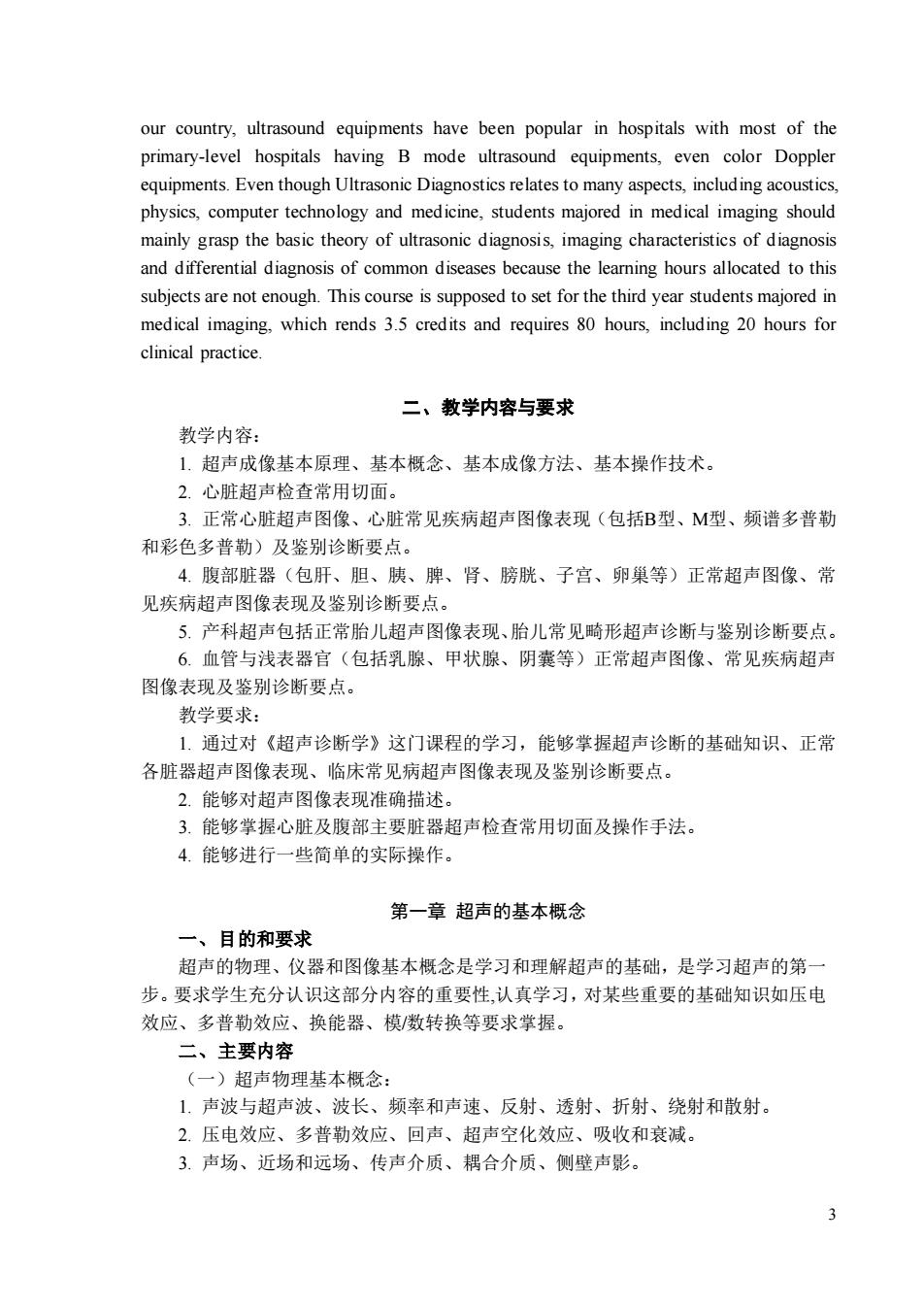正在加载图片...

our country,ultrasound equipments have been popular in hospitals with most of the primary-level hospitals having B mode ultrasound equipments,even color Doppler equipments.Even though Ultrasonic Diagnostics relates to many aspects,including acoustics physics,computer technology and medicine,students majored in medical imaging should mainly grasp the basic theory of ultrasonic diagnosis,imaging characteristics of dignosis and differential diagnosis of common diseases because the leamning hours allocated to this subjects are not enough.This course is supposed to set for the third year students majored in medical imaging.which rends 3.5 credits and requires 80 hours,including 20 hours for clinical practice. 二、教学内容与要求 教学内容: 1.超声成像基本原理、基本概念、基本成像方法、基本操作技术。 2.心脏超声检香常用切面 3.正常心脏超声图像、心脏常见疾病超声图像表现(包括B型、M型、频谱多普勒 和彩色多普勒)及鉴别诊断要点。 4.腹部脏器(包肝、胆、胰、脾、肾、膀胱、子宫、卵巢等)正常超声图像、常 见疾病超声图像表现及鉴别诊新要点 5.产科超声包括正常胎儿超声图像表现、胎儿常见畸形超声诊断与鉴别诊断要点。 6.血管与浅表器官(包括乳腺、甲状腺、阴囊等)正常超声图像、常见疾病超声 图像表现及鉴别诊断要点。 教学要求: 1.通过对《超声诊断学》这门课程的学习,能够掌握超声诊断的基础知识、正常 各脏器超声图像表现、临床常见病超声图像表现及鉴别诊断要点。 2.能够对绍声图像表现准确描述。 3.能够掌握心脏及腹部主要脏器超声检查常用切面及操作手法, 4.能够进行一些简单的实际操作。 第一章超声的基本概念 一、目的和要求 超声的物理、仪器和图像基本概念是学习和理解超声的基础,是学习超声的第 步。要求学生充分认识这部分内容的重要性,认真学习,对某些重要的基础知识如压电 效应、多普勒效应、换能器、模/数转换等要求掌握。 二、主要内容 (一)超声物理基本概念: 1.声波与超声波、波长、频率和声速、反射、透射、折射、绕射和散射 2.压电效应、多普勒效应、回声、超声空化效应、吸收和衰减。 3.声场、近场和远场、传声介质、耦合介质、侧壁声影。 3 our country, ultrasound equipments have been popular in hospitals with most of the primary-level hospitals having B mode ultrasound equipments, even color Doppler equipments. Even though Ultrasonic Diagnostics relates to many aspects, including acoustics, physics, computer technology and medicine, students majored in medical imaging should mainly grasp the basic theory of ultrasonic diagnosis, imaging characteristics of diagnosis and differential diagnosis of common diseases because the learning hours allocated to this subjects are not enough. This course is supposed to set for the third year students majored in medical imaging, which rends 3.5 credits and requires 80 hours, including 20 hours for clinical practice. 二、教学内容与要求 教学内容: 1. 超声成像基本原理、基本概念、基本成像方法、基本操作技术。 2. 心脏超声检查常用切面。 3. 正常心脏超声图像、心脏常见疾病超声图像表现(包括B型、M型、频谱多普勒 和彩色多普勒)及鉴别诊断要点。 4. 腹部脏器(包肝、胆、胰、脾、肾、膀胱、子宫、卵巢等)正常超声图像、常 见疾病超声图像表现及鉴别诊断要点。 5. 产科超声包括正常胎儿超声图像表现、胎儿常见畸形超声诊断与鉴别诊断要点。 6. 血管与浅表器官(包括乳腺、甲状腺、阴囊等)正常超声图像、常见疾病超声 图像表现及鉴别诊断要点。 教学要求: 1. 通过对《超声诊断学》这门课程的学习,能够掌握超声诊断的基础知识、正常 各脏器超声图像表现、临床常见病超声图像表现及鉴别诊断要点。 2. 能够对超声图像表现准确描述。 3. 能够掌握心脏及腹部主要脏器超声检查常用切面及操作手法。 4. 能够进行一些简单的实际操作。 第一章 超声的基本概念 一、目的和要求 超声的物理、仪器和图像基本概念是学习和理解超声的基础,是学习超声的第一 步。要求学生充分认识这部分内容的重要性,认真学习,对某些重要的基础知识如压电 效应、多普勒效应、换能器、模/数转换等要求掌握。 二、主要内容 (一)超声物理基本概念: 1. 声波与超声波、波长、频率和声速、反射、透射、折射、绕射和散射。 2. 压电效应、多普勒效应、回声、超声空化效应、吸收和衰减。 3. 声场、近场和远场、传声介质、耦合介质、侧壁声影